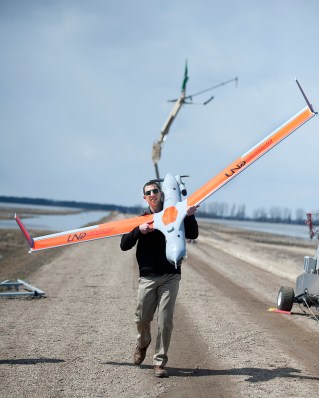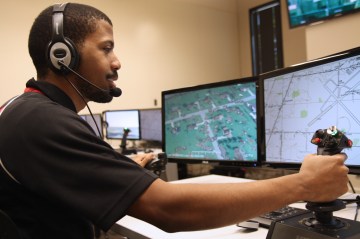The Raytheon Cobra is one of several unmanned aircraft used by researchers and students at the University of North Dakota
Zachary Waller always wanted to be a commercial airline pilot as a kid. The prestige and paycheck associated with being the captain of a huge airliner appealed to him. But shortly after he arrived at the University of North Dakota in 2008, he realized he could actually take to the skies and secure a good job without having his feet leave the ground. He decided to pursue a new degree that the department of aviation was offering — unmanned-aircraft-systems operations. He spent his college years studying drones.
“There were no textbooks,” Waller says of the program’s early years. “Nothing like this had ever been taught in an academic setting.” When he began studying unmanned aircraft in 2009, there were about 15 students in the major. Today, 120 students are enrolled in the program.
It’s not just a North Dakota phenomenon. Curriculums and research projects related to drones are cropping up at both large universities and community colleges across the country. In a list of 81 publicly funded entities that have applied for a certificate of authorization to fly drones from the Federal Aviation Administration (FAA), more than a third are colleges, according to FAA documents obtained by the Electronic Frontier Foundation. Schools — and their students — are jockeying for a position on the ground floor of a nascent industry that looks poised to generate jobs and research funding in the coming years.
“We get a lot of inquiries from students saying, ‘I want to be a drone pilot,’” says Ken Polovitz, the assistant dean in the University of North Dakota’s John D. Odegard School of Aerospace Sciences. “The Grand Forks region has become a hotbed for unmanned aircraft systems (UAS).”
(MORE: Drone Home)
The UAS operations major combines both manned and unmanned aerial training. Students first earn a commercial pilot certificate with multiengine and instrument ratings, meaning they’d have almost all the qualifications necessary to fly a Boeing jet for Delta Air Lines. After they’ve proved their traditional piloting abilities, they begin learning about unmanned aircraft. Different classes focus on operating drone cameras, ground systems and communications platforms. In the major’s capstone course, students complete 19 lessons — about 70 hours — in a flight simulator modeled after Boeing’s Scan Eagle, an unmanned aircraft system that’s been in military use since 2004. As a final project, students draft a mock application for drone flight, developing a flight-operations and safety plan that could hopefully pass muster if submitted to the FAA.

A University of North Dakota student uses a Scan Eagle unmanned aircraft at a test site in Oslo, Minn.
During class the students don’t actually operate any of the 10 or so drones that the university owns, but some undergrads involved in the department’s research on integrating drones into national airspace have used the vehicles. So far around 50 students, a mixture of traditional college-age kids and military veterans, have completed the program. While some, like Waller, engage in drone research, many now work for defense contractors. “Right now, the jobs for the graduates are generally with these companies and generally related to military and law-enforcement operations,” Polovitz says.
Smaller schools are also training students. Sinclair Community College in Dayton, Ohio, offers a three-semester technical certificate that focuses on mission planning, data management and drone maintenance to help graduates land an entry-level job in the unmanned-aircraft industry. The school also offers one- and two-day workshops on topics like current drone law and applying for flight authorization through the FAA.
Deb Norris, Sinclair’s vice president for Workforce Development and Corporate Services, says the school developed a drone curriculum to prepare for jobs of the future. “From a community-college perspective, it’s very, very important to be aligned with our region and our state industry and where we’re headed,” she says. “If this is one of those next transformational strategies, we need to do everything we can to keep that industry here and to help it from a growth perspective.”
(MORE: Photographs of Everyday Drones)
Schools are also working with local law enforcement to help them learn how to use unmanned aircraft. In Starkville, Miss., the local police department acquired a Parrot AR Drone through a partnership with Mississippi State University. The University of North Dakota is currently engaged in a research project with the Grand Forks County Sheriff’s Department, training police officers on the use of drones and partnering with police on missions that cover a 16-county area.
“We manage the program, we provide the pilots, we dispatch the aircraft,” says Al Frazier, an assistant professor of aviation at the University of North Dakota who spent 30 years in law enforcement himself. “The role that the sheriff’s department plays is that they provide the law-enforcement officer, the law-enforcement expertise and the repository of any evidence that is gained when we utilize the aircraft.”
So far the unmanned aircraft being used for the research project — a Raven-B DDL and a Draganflyer X6 — haven’t been on an actual mission yet, but Frazier says they’ll soon be deployed to take photographs over traffic accidents, provide assessment of disaster areas and search for missing persons or serious-crime suspects.
It’s proposed uses of unmanned aircraft by law enforcement that have sown political opposition in recent months. Right now at least least 32 states have pending legislation limiting drone flight, including North Dakota. Some students also aren’t onboard with the idea of bringing drones to campus. At Virginia Commonwealth University, students launched a Facebook petition asking administrators to suspend drone research because the aircraft are used as weaponized killers abroad.

Trace Curry, a former student at Sinclair Community College, operates an unmanned-aircraft simulator during class
While the appropriate uses of drones remain ethically ambiguous, schools will have to be careful in how they integrate them into their curriculums, says Jennifer Lynch, a staff attorney for the Electronic Frontier Foundation. “They should be teaching students about privacy issues and civil-liberties issues, and they should have a policy in place for how they’re going to store data, who they’re going to share it with and when they’re going to destroy it if it involves any information about humans,” she says.
Both North Dakota and Sinclair have classes that focus on drone law and privacy issues. In October, North Dakota created a UAS Research Compliance Committee in response to growing privacy concerns. All of the university’s drone-research projects must first receive approval from this committee, which includes law-enforcement officials, lawyers, city planners and professors.
(MORE: Why We Shouldn’t Fear Personal Drones)
For the students studying in the controversial field, it can be a challenge to get friends and family to look past the scary headlines that drones garner. “It’s real hard to get it across — even to my own parents,” says Trace Curry, a graduate of Sinclair Community College’s certificate program. “When I tell them this is what I’m doing, they’re like, ‘Oh, you’re not going to be one of those guys spying on the neighbors or shooting people overseas?’ No, that is not all they do.”
Even as lawmakers attempt to slam the brakes on drone adoption, schools may soon find them more accessible. The FAA is launching six test sites this year where drones will be allowed in the national airspace in preparation for their full rollout across U.S. skies in 2015. Fifty applicants from 37 states have applied to host a test site, including the regions where Sinclair and the University of North Dakota reside.
Having a test site nearby will allow for “more hands-on training by our students, where they’ll actually be flying aircraft,” Polovitz says. “It’s going to be a stimulus to get private funds to flow in for research and training.” Already drones have proved to be effective in luring investment dollars into North Dakota — the school’s unmanned-aircraft projects have netted $20 million in state and federal funding since 2008.
School officials say the job opportunities for drone experts will be varied once the machines are fully integrated into American skies. Emergency first responders are expected to adopt them, and the ability to gather precise agricultural data will likely transform farming, a huge industry in North Dakota. Even journalism will likely be affected — the University of Nebraska—Lincoln and the University of Missouri are already using drones to teach students new reporting techniques.
Whatever the use of unmanned aircraft, colleges are confident that drones are coming, and the jobs are coming with them. “People are starting to recognize it’s not a fad,” says Mark Hastings, the chief pilot for unmanned aircraft systems at North Dakota. “It is the next evolution of aviation. It’s appealing to students to know that they’re going to be getting in on still a very young industry. That provides a lot of potential opportunities.”

